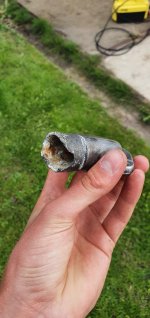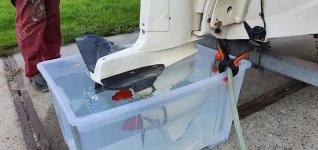Bart_Postmus
New member
Hi all, I'm a proud owner of a Shakespeare Shadow speedboat. The boat is equipped with a Volvo Penta AQ120A inboard engine form around 1964. The engine runs perfectly fine, but it starts to overheat when idling.
The strange thing is that the engine merely overheats when the sterndrive is in downward position (its normal position when driving the boat). As soon as I tilt the sterndrive upwards, the temperature starts to drop to its normal operating temperature of 65 degrees Celsius. It gets stranger though: when I start the engine whilst the sterndrive is in upward position, and I then lower the sterndrive to its downward position and shift the engine in forward gear, the cooling system works perfectly fine. As soon as the engine is at idle, it starts to overheat again in a few minutes.
When starting the engine whilst the sterndrive is in downward position, and I then shift the engine in forward gear, it would still overheat.
The thermostat looks a bit rusty but opens up nicely at 60 degrees Celsius. I replaced the impeller and checked some hoses, which all seemed fine. There is no air leak as far as I can tell. I attached an external hose to the impeller house and put the other end of the hose in a bucket of water, which I had to refill every minute whilst the engine was running. The temperature remained at 60 degrees Celsius.
My conclusion is that there must be a blockage in the water inlet on the sterndrive. However, when I blow air through the hose that is connected to the inlet, air bubbles come out of the inlet and I experience minimal resistance when doing it, which indicates that there is no such blockage in the water inlet.
I hope I gave you guys sufficient information to form a possible solution to my problem. Thank you in advance and I'm looking forward to your reactions!
The strange thing is that the engine merely overheats when the sterndrive is in downward position (its normal position when driving the boat). As soon as I tilt the sterndrive upwards, the temperature starts to drop to its normal operating temperature of 65 degrees Celsius. It gets stranger though: when I start the engine whilst the sterndrive is in upward position, and I then lower the sterndrive to its downward position and shift the engine in forward gear, the cooling system works perfectly fine. As soon as the engine is at idle, it starts to overheat again in a few minutes.
When starting the engine whilst the sterndrive is in downward position, and I then shift the engine in forward gear, it would still overheat.
The thermostat looks a bit rusty but opens up nicely at 60 degrees Celsius. I replaced the impeller and checked some hoses, which all seemed fine. There is no air leak as far as I can tell. I attached an external hose to the impeller house and put the other end of the hose in a bucket of water, which I had to refill every minute whilst the engine was running. The temperature remained at 60 degrees Celsius.
My conclusion is that there must be a blockage in the water inlet on the sterndrive. However, when I blow air through the hose that is connected to the inlet, air bubbles come out of the inlet and I experience minimal resistance when doing it, which indicates that there is no such blockage in the water inlet.
I hope I gave you guys sufficient information to form a possible solution to my problem. Thank you in advance and I'm looking forward to your reactions!
Last edited:




